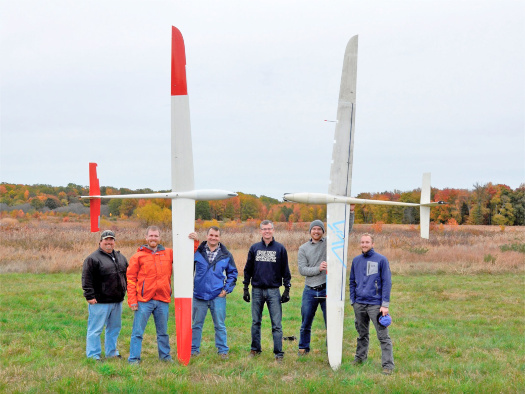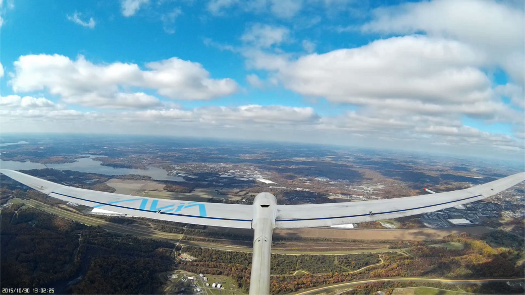 |
| February 02, 2016 | Volume 12 Issue 05 |
Designfax weekly eMagazine
Archives
Partners
Manufacturing Center
Product Spotlight
Modern Applications News
Metalworking Ideas For
Today's Job Shops
Tooling and Production
Strategies for large
metalworking plants
Wings:
Navy tests cooperative soaring concept for sustained flight of UAV sailplanes

NRL team members (left to right) Chris Bovais, Dan Edwards, and Trent Young and PSU team members Jack Langelaan, Nate Depenbusch, and John Bird combined efforts to demonstrate sustained unmanned, powerless flight of two cooperative-soaring UAVs. [U.S. Naval Research Laboratory]
The U.S. Naval Research Laboratory (NRL), in collaboration with the Air Vehicle Intelligence and Autonomy (AVIA) Lab at Pennsylvania State University (PSU), completed testing of cooperative autonomous soaring algorithms used to keep unmanned sailplanes aloft for sustained flight durations -- demonstrating the concept of shared soaring data between two unmanned aerial vehicles (UAVs) in flight.
During the weeks of Sept. 28 and Oct. 26, 2015, the team launched 23 flights over a nine-day period resulting in greater than 30 hours of combined flight. The tests, conducted within restricted airspace at Phillips Army Airfield, Aberdeen Proving Grounds, MD, culminated with two "powered" sailplanes sharing telemetry data and cooperatively and autonomously soaring at altitudes in excess of 1 km and for flight durations of over five hours.
The NRL-developed Autonomous Locator of Thermals (ALOFT) autonomous soaring algorithm guided NRL's aircraft. The PSU aircraft was guided onboard by the AVIA-developed AutoSOAR autonomous soaring algorithm, which drew inspiration from NRL's ALOFT techniques. AutoSOAR's addition of a series of atmospheric mapping and collision-avoidance algorithms demonstrated in-flight cooperation between the two aircraft on multiple flights.
"Autonomous soaring algorithms seek out naturally occurring areas of rising air called thermals," said Dr. Dan Edwards, aerospace engineer and principle investigator of the solar-soaring program. "Cooperative autonomous soaring combines data from multiple autonomous soaring aircraft to make a more complete measurement of the local atmospheric conditions. This atmospheric map is then integrated to guide both aircraft toward strong lift activity quicker than if it was just a single aircraft, a technique very similar to that used by a flock of soaring birds."

Researchers at the U.S. Naval Research Laboratory (NRL) and the Air Vehicle Intelligence and Autonomy (AVIA) Lab at Pennsylvania State University (PSU) demonstrate autonomous soaring algorithms used to keep unmanned sailplanes aloft for sustained flight durations, a benefit aimed at improving the availability of data for a 24-7 Information, Surveillance, and Reconnaissance (ISR) mission. This image captures a view taken from a tail-mounted camera onboard the PSU aircraft at 1 km above Aberdeen Phillips Army Airfield. [Pennsylvania State University]
Both aircraft demonstrated a robust autonomous soaring capability during the two weeks of testing.
PSU's aircraft flew multiple 2.5-hour flights despite carrying a battery with only enough capacity for 4 minutes of motor run-time. NRL's best soaring flight was 5.3 hours while only running a motor-driven propeller for 27 minutes. Both aircraft rode thermals to altitudes in excess of 1,400 m, with several individual climbs in excess of 1,000 m using nothing more than the power of the atmosphere.
"These tests showed both the NRL and PSU's autonomous soaring algorithms are successful at finding and using thermals by themselves," Edwards said. "More importantly, this testing showed proof of concept on multiple occasions, with both aircraft finding thermals and 'calling' the other aircraft over to use the same area of lift to increase endurance of the swarm."
Future testing will focus on reducing the separation distance such that both aircraft can actively soar in the same thermal at the same altitude. The team will also investigate the inclusion of solar photovoltaics to the cooperative autonomous soaring techniques, enabling long-endurance flights of unmanned sailplanes using the power of the sun.
Solar photovoltaics will allow conversion of solar radiation directly to electricity to charge batteries or provide power for longer endurance or payloads. NRL is developing "drop-in" power electronics and solar wings, which will enable charging batteries and aiming for overnight flight.
The Solar Photovoltaic and Autonomous Soaring Base Program and the US Marine Corps' Expeditionary Energy Office Cooperative-Soaring Program are aiming to improve the availability of a 24-7 Information, Surveillance, and Reconnaissance (ISR) mission without using logistics fuel, benefitting the expeditionary warfighter by enhancing the endurance of existing and future UAV assets.
Source: U.S. Naval Research Laboratory
Published February 2016
Rate this article
View our terms of use and privacy policy
